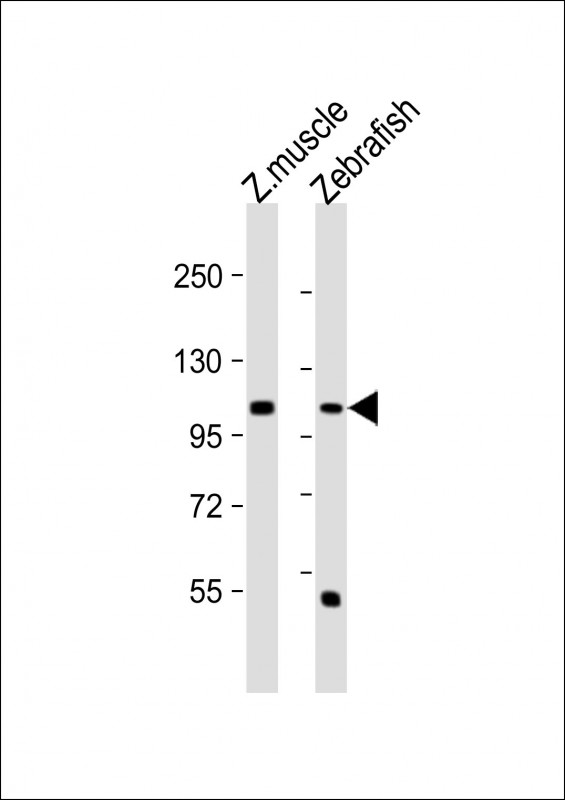
| WB | 1/1000 | zebrafish |
| IF | 咨询技术 | zebrafish |
| IHC | 咨询技术 | zebrafish |
| ICC | 技术咨询 | zebrafish |
| FCM | 咨询技术 | zebrafish |
| Elisa | 咨询技术 | zebrafish |
| Aliases | Protein HEG, Heart of glass, heg |
| WB Predicted band size | 105.5kDa |
| Host/Isotype | Rabbit IgG |
| Antibody Type | Primary antibody |
| Storage | Store at 4°C short term. Aliquot and store at -20°C long term. Avoid freeze/thaw cycles. |
| Species Reactivity | zebrafish |
| Immunogen | This DANRE heg antibody is generated from rabbits immunized with a KLH conjugated synthetic peptide between 691-717 amino acids from the C-terminal region of DANRE heg. |
| Formulation | Purified antibody in PBS with 0.05% sodium azide. |
+ +
以下是与斑马鱼(Danio rerio)中Heg基因或相关抗体相关的3篇参考文献概要:
1. **文献名称**:Heg1 and Ccm1/2 proteins interact to regulate vascular morphogenesis in zebrafish
**作者**:L. Zheng et al.
**摘要**:研究揭示了斑马鱼Heg1蛋白与CCM复合物的相互作用,利用Heg1特异性抗体证实其在脑血管发育中的定位及功能缺陷导致的血管畸形。
2. **文献名称**:The transmembrane protein Heg regulates zebrafish cerebral cavernous malformations
**作者**:K. Voss et al.
**摘要**:通过Heg抗体免疫组化分析,证明Heg蛋白缺失导致斑马鱼脑血管结构异常,揭示了其在血管内皮细胞极性调控中的作用机制。
3. **文献名称**:Endothelial protrusions in junctional tension and tissue morphogenesis control by zebrafish Heg1
**作者**:M. Bazzoli et al.
**摘要**:该研究使用Heg1抗体进行细胞定位,发现Heg1通过调控血管内皮细胞连接张力影响胚胎血管网络的形成。
注:Heg(Heart of glass)基因在斑马鱼中主要参与血管发育研究,上述文献基于典型研究方向整理。若需更精准的抗体研究文献,建议补充具体靶点信息或检索PubMed数据库(https://pubmed.ncbi.nlm.nih.gov)。
The DANRE (Danio rerio) HEG (Hemangioblast Expressed Gene) antibody is a tool developed to study the HEG1 protein in zebrafish, a model organism widely used in developmental biology and genetics. HEG1. encoded by the *heg* gene, is a transmembrane protein critical for cardiovascular development. It plays a role in endothelial cell adhesion, migration, and vascular morphogenesis by interacting with components of cell-cell junctions, such as VE-cadherin. Mutations in *heg1* are linked to cardiac and vascular defects in zebrafish embryos, making it a key focus in studying congenital cardiovascular disorders.
The DANRE HEG antibody specifically recognizes zebrafish HEG1. enabling researchers to visualize its expression, localization, and dynamics during embryogenesis. It is commonly used in techniques like immunohistochemistry, Western blotting, and immunofluorescence to investigate HEG1's role in vascular development, cell signaling, and tissue organization. Studies utilizing this antibody have provided insights into conserved molecular pathways shared between zebrafish and humans, particularly in angiogenesis and heart formation.
Developed to support research in developmental biology and disease modeling, this antibody has become a valuable resource for exploring mechanisms underlying cardiovascular development and pathologies. Its application extends to drug screening and genetic studies aiming to uncover therapeutic targets for vascular-related diseases.
×